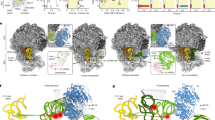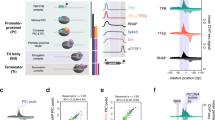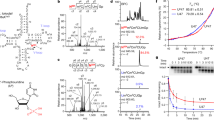Abstract
The ribonuclease FttA (also known as aCPSF and aCPSF1) mediates factor-dependent transcription termination in archaea1,2,3. Here we report the structure of a Thermococcus kodakarensis transcription pre-termination complex comprising FttA, Spt4, Spt5 and a transcription elongation complex (TEC). The structure shows that FttA interacts with the TEC in a manner that enables RNA to proceed directly from the TEC RNA-exit channel to the FttA catalytic centre and that enables endonucleolytic cleavage of RNA by FttA, followed by 5′→3′ exonucleolytic cleavage of RNA by FttA and concomitant 5′→3′ translocation of FttA on RNA, to apply mechanical force to the TEC and trigger termination. The structure further reveals that Spt5 bridges FttA and the TEC, explaining how Spt5 stimulates FttA-dependent termination. The results reveal functional analogy between bacterial and archaeal factor-dependent termination, functional homology between archaeal and eukaryotic factor-dependent termination, and fundamental mechanistic similarities in factor-dependent termination in bacteria, archaea, and eukaryotes.
This is a preview of subscription content, access via your institution
Access options
Access Nature and 54 other Nature Portfolio journals
Get Nature+, our best-value online-access subscription
$32.99 / 30 days
cancel any time
Subscribe to this journal
Receive 51 print issues and online access
$199.00 per year
only $3.90 per issue
Buy this article
- Purchase on SpringerLink
- Instant access to full article PDF
Prices may be subject to local taxes which are calculated during checkout




Similar content being viewed by others
Data availability
Cryo-EM maps and atomic coordinates generated in this work are available from the Electron Microscopy Database (EMDB accession codes EMD-44438, EMD-44454, EMD-44439, EMD-44455, EMD-44649, and EMD-44650) and the Protein Database (PDB accessions 9BCT and 9BCU). Unique biological materials will be made available to qualified investigators on request.
References
Sanders, T. et al. FttA is a CPSF73 homologue that terminates transcription in Archaea. Nat. Microbiol. 5, 545–553 (2020).
Yue, L. et al. The conserved ribonuclease aCPSF1 triggers genome-wide transcription termination of Archaea via a 3′-end cleavage mode. Nucleic Acids Res. 48, 9589–9605 (2020).
Li, J. et al. aCPSF1 cooperates with terminator U-tract to dictate archaeal transcription termination efficacy. eLife 10, e70464 (2021).
Phung, D. et al. Archaeal β-CASP ribonucleases of the aCPSF1 family are orthologs of the eukaryal CPSF-73 factor. Nucleic Acids Res. 41, 1091–1103 (2013).
Nishida, Y. et al. Crystal structure of an archaeal cleavage and polyadenylation specificity factor subunit from Pyrococcus horikoshii. Proteins 78, 2395–2398 (2010).
Mir-Montazeri, B., Ammelburg, M., Forouzan, D., Lupas, A. & Hartmann, M. Crystal structure of a dimeric archaeal cleavage and polyadenylation specificity factor. J. Struct. Biol. 173, 191–195 (2011).
Silva, A. et al. Structure and activity of a novel archaeal beta-CASP protein with N-terminal KH domains. Structure 19, 622–632 (2011).
Fianu, I. et al. Structural basis of Integrator-mediated transcription regulation. Science 374, 883–887 (2021).
Zheng, H. et al. Structural basis of INTAC-regulated transcription. Protein Cell 14, 698–702 (2023).
Fianu, I. et al. Structural basis of Integrator-dependent RNA polymerase II termination. Nature 629, 219–227 (2024).
Lykke-Andersen, S. et al. Integrator is a genome-wide attenuator of non-productive transcription. Mol. Cell 81, 514–529 (2021).
Wagner, E., Tong, L. & Adelman, K. Integrator is a global promoter-proximal termination complex. Mol. Cell 83, 416–427 (2023).
Sun, Y., Hamilton, K. & Tong, L. Recent molecular insights into canonical pre-mRNA 3′-end processing. Transcription 11, 83–96 (2020).
Eaton, J. & West, S. Termination of transcription by RNA polymerase II. Trends Genet. 36, 664–675 (2020).
Rodriguez-Molina, J., West, S. & Passmore, L. Knowing when to stop: transcription termination on protein-coding genes by eukaryotic RNAPII. Mol. Cell 83, 404–415 (2023).
Boreikaite, V. & Passmore, L. 3′-End processing of eukaryotic mRNA: machinery, regulation, and impact on gene expression. Ann. Rev. Biochem. 92, 199–225 (2023).
Werner, F. A nexus for gene expression-molecular mechanisms of Spt5 and NusG in the three domains of life. J. Mol. Biol. 417, 13–27 (2012).
Tomar, S. & Artsimovitch, I. NusG–Spt5 proteins-universal tools for transcription modification and communication. Chem. Rev. 113, 8604–8619 (2013).
Song, A. & Chen, F. The pleiotropic roles of SPT5 in transcription. Transcription 13, 53–69 (2022).
Molodtsov, V., Wang, C., Firlar, E., Kaelber, J. & Ebright, R. H. Structural basis of Rho-dependent transcription termination. Nature 614, 367–374 (2023).
Kang, J. et al. Structural basis for transcript elongation control by NusG family universal regulators. Cell 173, 1650–1662 (2018).
Delbeau, M. et al. Structural and functional basis of the universal transcription factor NusG pro-pausing activity in Mycobacterium tuberculosis. Mol. Cell 83, 1474–1488 (2023).
Vishwakarma, R., Qayyum, M., Babitzke, P. & Murakami, K. Allosteric mechanism of transcription inhibition by NusG-dependent pausing of RNA polymerase. Proc. Natl Acad. Sci. USA 120, e2218516120 (2023).
Ehara, H. et al. Structure of the complete elongation complex of RNA polymerase II with basal factors. Science 357, 921–924 (2017).
Wang, C. et al. Structural basis of transcription–translation coupling. Science 369, 1359–1365 (2020).
Molodtsov, V. et al. Structural basis of RfaH-mediated transcription–translation coupling. Nature Struct. Mol. Biol. https://doi.org/10.1038/s41594-024-01372-w (2024).
Sun, Y. et al. Structure of an active human histone pre-mRNA 3′-end processing machinery. Science 367, 700–703 (2020).
Whitelaw, E. & Proudfoot, N. Alpha-thalassaemia caused by a poly(A) site mutation reveals that transcriptional termination is linked to 3′ end processing in the human alpha 2 globin gene. EMBO J. 5, 2915–2922 (1986).
Kim, M. et al. The yeast Rat1 exonuclease promotes transcription termination by RNA polymerase II. Nature 432, 517–522 (2004).
West, S., Gromak, N. & Proudfoot, N. Human 5′→3′ exonuclease Xrn2 promotes transcription termination at co-transcriptional cleavage sites. Nature 432, 522–525 (2004).
Luo, W. & Bentley, D. A ribonucleolytic rat torpedoes RNA polymerase II. Cell 119, 911–914 (2004).
Tollervey, D. Termination by torpedo. Nature 432, 456–457 (2004).
Baejen, C. et al. Genome-wide analysis of RNA polymerase II termination at protein-coding genes. Mol. Cell 66, 38–49.e6 (2017).
Fong, N. et al. Effects of transcription elongation rate and Xrn2 exonuclease activity on RNA polymerase II termination suggest widespread kinetic competition. Mol. Cell 60, 256–267 (2015).
Eaton, J. et al. Xrn2 accelerates termination by RNA polymerase II, which is underpinned by CPSF73 activity. Genes Dev. 32, 127–139 (2018).
Cortazar, M. et al. Xrn2 substrate mapping identifies torpedo loading sites and extensive premature termination of RNA pol II transcription. Genes Dev. 36, 1062–1078 (2022).
Zeng, Y., Zhang, H. W., Wu, X. X. & Zhang, Y. Structural basis of exoribonuclease-mediated mRNA transcription termination. Nature 628, 887–893 (2024).
Yanagisawa, T. et al. Structural basis of eukaryotic transcription termination by the Rat1 exonuclease complex. Preprint at bioRxiv https://doi.org/10.1101/2024.03.28.587100 (2024).
Larson, M., Greenleaf, W., Landick, R. & Block, S. Applied force reveals mechanistic and energetic details of transcription termination. Cell 132, 971–982 (2008).
Santangelo, T. & Roberts, J. Forward translocation is the natural pathway of RNA release at an intrinsic terminator. Mol. Cell 14, 117–126 (2004).
Park, J. & Roberts, J. Role of DNA bubble rewinding in enzymatic transcription termination. Proc. Natl Acad. Sci. USA 103, 4870–4875 (2006).
Ray-Soni, A., Bellecourt, M. & Landick, R. Mechanisms of bacterial transcription termination. Annu. Rev. Biochem. 85, 319–347 (2016).
Roberts, J. Mechanisms of bacterial transcription termination. J. Mol. Biol. 431, 4030–4039 (2019).
Epshtein, V., Cardinale, C., Ruckenstein, A., Borukhov, S. & Nudler, E. An allosteric path to transcription termination. Mol. Cell 28, 991–1001 (2007).
Epshtein, V., Dutta, D., Wade, J. & Nudler, E. An allosteric mechanism of Rho-dependent transcription termination. Nature 463, 245–249 (2010).
Webster, M. et al. Structural basis of transcription–translation coupling and collision in bacteria. Science 369, 1355–1359 (2020).
Blaha, G. & Wade, J. Transcription–translation coupling in bacteria. Annu. Rev. Genet. 56, 9.1–9.19 (2022).
French, S., Santangelo, T., Beyer, A. & Reeve, J. Transcription and translation are coupled in Archaea. Mol. Biol. Evol. 24, 893–895 (2007).
Weixlbaumer, A., Grunberger, F., Werner, F. & Grohmann, D. Coupling of transcription and translation in archaea: cues from the bacterial world. Front. Microbiol. 12, 661827 (2021).
Grana, D., Gardella, T. & Susskind, M. The effects of mutations in the ant promoter of phage P22 depend on context. Genet. 120, 319–327 (1988).
Sambrook, J., Fritsch, E. & Maniatis, T. Molecular Cloning: A Laboratory Manual (Cold Spring Harbor Laboratory, 1989).
Punjani, A., Rubinstein, J., Fleet, D. & Brubaker, M. cryoSPARC: algorithms for rapid unsupervised cryo-EM structure determination. Nat. Methods 14, 290–296 (2017).
Pettersen, E. et al. UCSF chimera: a visualization system for exploratory research and analysis. J. Comput. Chem. 25, 1605–1612 (2004).
Jun, S.-H. et al. Direct binding of TFEα opens DNA binding cleft of RNA polymerase. Nat. Commun. 11, 6123 (2020).
Klein, B. J. et al. RNA polymerase and transcription elongation factor Spt4/5 complex structure. Proc. Natl Acad. Sci. USA 108, 46–550 (2011).
Emsley, P., Lohkamp, B., Scott, W. & Cowtan, K. Features and development of Coot. Acta Crystallogr. D 66, 486–501 (2010).
Afonine, T., Headd, J., Terwilliger, T. & Adams, P. Computational Crystallography Newsletter 4, 43–44; https://phenix-online.org/phenixwebsite_static/mainsite/files/newsletter/CCN_2013_07.pdf (2013).
Suloway, C. et al. Automated molecular microscopy: the new Leginon system. J. Struct. Biol. 151, 41–60 (2005).
Acknowledgements
The authors thank the Rutgers Cryo-EM and Nanoimaging Facility, the Rutgers NJMS Cryo-EM Core Facility, the BNL Laboratory for BioMolecular Structure (supported by DOE Office of Biological and Environmental Research project KP1607011), and the National Center for CryoEM Access and Training (supported by NIH grant GM129539, Simons Foundation grant SF349247, and New York state grants) for microscope access; and the SIII Center (supported by Shanghai Science and Technology Innovation Action Plan grant 23JC1404201 to C.W) for computer resources. This work was supported by National Institutes of Health (NIH) grants GM100329 and GM143963 to T. J. Santangelo and GM041376 to R.H.E.
Author information
Authors and Affiliations
Contributions
L.Y., V.M., T. J. Santangelo, and R.H.E. designed experiments. L.Y., V.M., K.K., X.M., B.W., P.U., C.J.M., T. J. Sanders, and T. J. Santangelo prepared proteins and nucleic acids and performed biochemical experiments. L.Y., V.M., C.W., X.M., E.F., and J.T.K. performed cryo-EM data collection. L.Y., V.M., C.W., T. J. Santangelo, and R.H.E. analysed data. L.Y., C.W., and R.H.E. prepared figures. R.H.E. wrote the manuscript.
Corresponding author
Ethics declarations
Competing interests
The authors declare no competing interests.
Peer review
Peer review information
Nature thanks Nick Proudfoot and the other, anonymous, reviewer(s) for their contribution to the peer review of this work. Peer review reports are available.
Additional information
Publisher’s note Springer Nature remains neutral with regard to jurisdictional claims in published maps and institutional affiliations.
Extended data figures and tables
Extended Data Fig. 1 Nucleic acids and proteins.
a, Nucleic-acid scaffolds for structural studies: TEC44 and TEC52. Black, DNA; brick red, RNA; dashed rectangle, TEC. b, Nucleic-acid scaffold and RNA markers for biochemical studies: F-TEC44, F-RNA22, F-RNA24, and F-RNA26. F, fluorescein. Other features as in a. c, Proteins for structural and biochemical studies (Coomassie-stained PAGE). The analysis was performed twice, with consistent results obtained.
Extended Data Fig. 2 Structure determination: Tko FttA(H255A/H591A)–Spt4–Spt5–TEC44.
a, Data processing scheme (Extended Data Table 1). b, Representative electron microphotograph. c, 2D class averages. d,e, EM density map coloured by local resolution for global map (map 1a) and locally refined map for FttA, RNAP stalk, and Spt5 KOW (map 1b). f–h, Fourier-shell correlation (FSC) plot, orientation distribution plot, and 3D FSC plot for map 1a. i–k, Fourier-shell correlation (FSC) plot, orientation distribution plot, and 3D FSC plot for map 1b.
Extended Data Fig. 3 Structure: Tko FttA(H255A/H591A)–Spt4–Spt5–TEC44.
a–j, Representative EM density (isocontours) and fits (Cα traces for backbones; sticks for sidechains) for FttAprox, FttAdist, RNAP stalk (RpoE and RpoF), Spt5, RNA interacting with FttAprox, RNA interacting with FttAdist, interface between FttAprox and RNAP RpoA’ and RpoB, interface between FttAprox and RNAP stalk (RpoE and RpoF), interface between FttAprox and Spt5, and interface between FttAdist and Spt5. Colours as in Fig. 2.
Extended Data Fig. 4 Structure determination: Tko FttA(H255A/H591A)–Spt4–Spt5–TEC52.
a, Data processing scheme (Extended Data Table 1). b, Representative electron microphotograph. c, 2D class averages. d,e, EM density map coloured by local resolution for global map (map 2a) and locally refined map for FttA, RNAP stalk, and Spt5 KOW (map 2b). f–h, Fourier-shell correlation (FSC) plot, orientation distribution plot, and 3D FSC plot for map 2a. i–k, Fourier-shell correlation (FSC) plot, orientation distribution plot, and 3D FSC plot for map 2b.
Extended Data Fig. 5 Structure: Tko FttA(H255A/H591A)–Spt4–Spt5–TEC52.
a–j, Representative EM density (isocontours) and fits (Cα traces for backbones; sticks for sidechains) for FttAprox, FttAdist, RNAP stalk (RpoE and RpoF), Spt5, RNA interacting with FttAprox, RNA interacting with FttAdist, interface between FttAprox and RNAP RpoA’ and RpoB, interface between FttAprox and RNAP stalk (RpoE and RpoF), interface between FttAprox and Spt5, and interface between FttAdist and Spt5. Colours as in Fig. 2.
Extended Data Fig. 6 Structure: Tko FttA(H255A/H591A)–Spt4–Spt5–TEC44 and Tko FttA(H255A/H591A)–Spt4–Spt5–TEC52.
a, Comparison of structures Tko FttA(H255A/H591A)–Spt4–Spt5–TEC44 (left) and Tko FttA(H255A/H591A)–Spt4–Spt5–TEC52 (right). Colours as in Fig. 2. b, Sequence alignment of regions of archaeal Spt5 that contact nontemplate-strand DNA in Tko FttA(H255A/H591A)–Spt4–Spt5–TEC44 and Tko FttA(H255A/H591A)–Spt4–Spt5–TEC52 to corresponding regions of yeast and human Spt5, Bacillus subtilis and Mycobacterium tuberculosis NusG (which have “pro-pausing” activity and which make corresponding protein-DNA interactions22,23), and E. coli NusG (which has “anti-pausing” activity and which does not make corresponding protein-DNA interactions21). Arrows, β-strands; helices, α-helices; red dots, residues that contact nontemplate-strand DNA in Tko FttA(H255A/H591A)–Spt4–Spt5–TEC44 and Tko FttA(H255A/H591A)–Spt4–Spt5–TEC52. Boxes denote conserved sequence positions. Colours denote levels of sequence conservation (red fill with white letters, high conservation; red letters, moderate conservation).
Extended Data Fig. 7 Protein-RNA interactions by FttA and dimerization interface of FttA in Tko FttA(H255A/H591A)–Spt4–Spt5–TEC44 and Tko FttA(H255A/H591A)–Spt4–Spt5–TEC52.
a–f, Details of protein-RNA interactions by FttAprox, RNAP stalk, and FttAdist in Tko FttA(H255A/H591A)–Spt4–Spt5–TEC44 (panels a–c) and Tko FttA(H255A/H591A)–Spt4–Spt5–TEC52 (panels d–f). Colours as in Fig. 2. g,h, Interface between FttAprox and FttAdist in Tko FttA(H255A/H591A)–Spt4–Spt5–TEC44 (panel g) and Tko FttA(H255A/H591A)–Spt4–Spt5–TEC52 (panel h). Colours as in Fig. 2.
Extended Data Fig. 8 Protein-protein interactions by FttA: effects of alanine substitution of FttA residues that contact RNAP or Spt5 in Tko FttA(H255A/H591A)–Spt4–Spt5–TEC44 and Tko FttA(H255A/H591A)–Spt4–Spt5–TEC5252.
a, Effects of alanine substitution on FttA-dependent transcription termination and RNA cleavage, assessed in release assays with bead-immobilized promoter-generated TECs containing 32P-5’-end-labelled RNA, detecting retained or released RNA by storage-phosphor scanning (methods as in ref. 1 and Fig. 1b). P, pellet fraction; S, supernatant fraction. Top, gel image. Bottom, normalized efficiencies of FttA-dependent RNA cleavage [((RNA-cleavage efficiency)/(RNA-cleavage efficiency with wild-type FttA))100%]. Assays were performed twice, with consistent results obtained. For gel source data, see Supplementary Fig. 1. b, Effects of alanine substitution on FttA-dependent RNA cleavage, assessed in assays with TECs assembled on synthetic nucleic-acid scaffolds containing 44 nt fluorescein-5’-end-labelled nascent RNA, detecting intact and cleaved RNA by x/y fluorescence scanning (methods as in Fig. 1c). Top, gel image. Bottom, normalized efficiencies of FttA-dependent RNA cleavage [((RNA-cleavage efficiency)/(RNA-cleavage efficiency with wild-type FttA))100%]. Assays were performed twice, with consistent results obtained. For gel source data, see Supplementary Fig. 1.
Extended Data Fig. 9 Structural relationship between archaeal FttA-dependent pre-termination complex and eukaryotic XRN2-dependent termination complex.
Comparison of archaeal FttA-dependent pre-termination complex (left; Fig. 2) and yeast XRN2 (Rat1)-dependent termination complex (right; PDB 8JCH)37. In left panel, FttAprox KH1-KH2 domains and FttAdist are omitted for clarity. In right panel, Rai1 is omitted for clarity. Rat1, cyan. Other colours as in Fig. 2.
Supplementary information
Rights and permissions
Springer Nature or its licensor (e.g. a society or other partner) holds exclusive rights to this article under a publishing agreement with the author(s) or other rightsholder(s); author self-archiving of the accepted manuscript version of this article is solely governed by the terms of such publishing agreement and applicable law.
About this article
Cite this article
You, L., Wang, C., Molodtsov, V. et al. Structural basis of archaeal FttA-dependent transcription termination. Nature 635, 229–236 (2024). https://doi.org/10.1038/s41586-024-07979-9
Received:
Accepted:
Published:
Issue date:
DOI: https://doi.org/10.1038/s41586-024-07979-9
This article is cited by
-
Convergent and conserved roads lead to Rome: now archaea fill the gap of transcription termination
Science China Life Sciences (2025)



